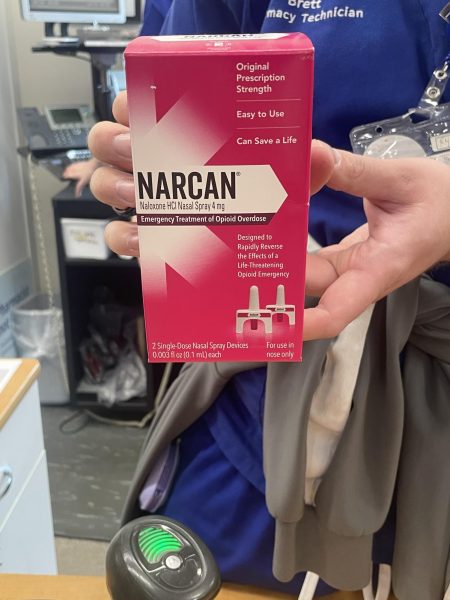How the Dress Code Punishes Girls for Boys’ Behavior
“Maybe you should cover up next time and then he wouldn’t have done that,” someone said.
A 15-year-old came to school in a crop top and high-waisted jeans in Sept. of 2018.
Her stomach wasn’t showing, but approximately 1/8th of her midriff was revealed.
She was in the library with her friends doing homework and goofing around. Principal Tony Srithai called her name while she walked towards her honors English class.
She immediately became uncomfortable and kept walking. He started to walk after her and called her name again.
“I know you heard me,” he said.
She immediately froze and turned around.
“You know you can’t wear that shirt to school. Let’s leave it at home next time.”
That girl was me.
I felt extremely embarrassed and ended up borrowing a jacket from a friend.
This frustrated me not only because I got dress coded, but because I was considered distracting enough to be followed down the hall.
Mine is one of many stories of girls in Beachwood who have been made to feel insecure or stilted by the dress code.
Examples such as these appear in the news every day from schools all over the country: students made to put duct tape over the holes in their jeans, students sent home for wearing tank tops, and in the most drastic of cases, students suspended and banned from graduation for dress code violations. There’s a common denominator in all of these cases: They’ve all been girls.
The Student-Parent Handbook was changed this year. The Dress and Grooming section now includes specific dress requirements including that students must have shoes on at all times and must not wear crop tops or low cut tops. It also bans some peculiar things like pajamas, hair in curlers or rollers, and costumes or “extra items” like towels, capes or blankets. However, in a surprising turn, the school tries to do something daring: banning ripped jeans.
“I feel it’s unnecessary,” said Malinda Creel, who wears ripped jeans frequently. “Ripped jeans are convenient, comfortable and not distracting. No one is going to look under desks in class to stare at someone’s jeans.”
Dress codes are intended to establish “appropriate” expectations for students and staff.
However, some students believe that the dress code is not emphasized enough.
“If I’m being honest, I’m not even sure what the dress code is,” said junior Teilah Simon, who was once dress coded for wearing a tank top. “I feel like there is no set dress code, but they kind of just tell people to change when they want to.”
Other students feel that the selective enforcement has racial implications.
“Not only is the dress code selective, it also seems oppressive,” said junior Stephen Fowler, who has never been dress coded. “I’ve seen my female friends of color get dress coded for something that their white counterparts have been able to get away with wearing.”
Sophomore Aaliyah Edwards, who has been dress coded for putting the hood of her sweatshirt up, brings up the rule against durags, or “wave caps.”
“I think it’s unfair that durags are not allowed to be worn in schools,” Edwards said.
Some believe the dress code should be dropped entirely if it is not going to be enforced consistently.
“I believe the dress code should treat everyone in the same [way] because either the dress code applies to everyone or no one,” sophomore Megan Wooley said. She has not been dress coded yet in high school.
Another student believes that students with larger chests are more likely to be called out for what they are wearing.
“A lot of the time, I wear outfits that would not fit the regulations stated in the dress code but because of the size of my chest, I can get away with it,” said one student, who has never been dress coded.
Mariana, a student whose name has been changed because she does not want to be identified, was a sophomore when she walked into her Honors Biology final wearing sweatpants and a crop top.
“I wanted to be comfortable during the test and didn’t feel like being cute,” she said.
She was reviewing with friends before the exam when a friend of hers walked up to her and gave her a hug. When he pulled away, he quickly squeezed her butt. Mariana was shocked and felt violated. She quickly moved to her seat.
She told her friends, who were shocked as well, but quickly laughed the situation off.
“Maybe you should cover up next time and then he wouldn’t have done that,” someone said.
Victim-blaming behavior such as this, whether coming from students or staff, can make young women feel unsafe and unable to express themselves the way they want to.
“Short tops” are the only clothing item that was specifically banned in last year’s dress code. The justification for this rule on crop tops is that they are potentially distracting, and the school is trying to prepare students for professional settings. But are they really setting their students up for greatness? Are crop tops distracting to students or more so to staff?
Students have mixed feelings about the value of dress codes.
“I think it’s a nice idea, but it’s badly written and enforced,” junior Ian Stender said, who has been dress coded multiple times for wearing baseball hats and sleeveless jerseys.
“There is no reason someone shouldn’t be able to wear a hat in school… Hats are personal expressions and cause no disruption to the learning environment,” he added. “Hats are mainstream and are not a security risk. If the 165 cameras in the school can’t spot someone’s face because they’re wearing a hat and/or sunglasses, I would be very surprised.”
Stender is the only boy of the many interviewed who has been formally dress coded.
“Dress codes aren’t beneficial, because if someone is distracted, it really won’t stop them from learning,” Wooley said. “Self control exists for a reason, so looking away and focusing on your work rather than telling a girl to cover up because you’re distracted makes more sense.”
Wooley makes a great point. Contrary to popular belief, girls do not wear revealing clothing to purposefully entice men. If I find a cute shirt at a store and it shows a little bit of my stomach or is a little low cut, I might purchase it because I feel good in it—not because I am trying to dress that way for a guy.
Patti said that he does not want the dress code to seem “punitive” to a student.
“If a teacher or staff member sees something, they will let me know and I will sit down with that student and talk about the rules,” he said. “I’ve never had to issue an out-of-school suspension for blatant disregard of the dress code.”
Some students actually believe a dress code is beneficial.
“Coming from a private school, it was nice having a strict dress code because I didn’t feel pressured to conform to current trends or have to look nice,” said Edwards, who used to attend a Christian private school. “However, I still believe Beachwood needs to be a little more ‘lax’ with the dress code because it truly isn’t distracting anyone as much as they think.”
If we have to have a dress code, it needs to be more clear, it needs to be enforced equitably to all students no matter their gender, race or body type and it needs to be enforced in a way so that every student in Beachwood feels comfortable expressing themselves.
When addressing students about their clothes, administrators should be sensitive. Speaking with a student one-on-one is more effective, and is less likely to make them feel uncomfortable.
Most importantly, the responsibility of the dress code should not rest entirely on the shoulders of girls (whether covered or not). Boys also need to be held accountable for their appearance, and must learn to treat others with respect and courtesy, no matter how they are dressed.

Carrington Peavy (she/her) began writing for the Beachcomber in 2017. She likes to cover in depth investigative stories. In addition to writing for the...

Amy Chen began working for the Beachcomber in the spring of 2018. In addition to managing site design, she illustrates and covers a variety of topics in...














Layla • Jul 30, 2023 at 1:19 PM
This isn’t fair that girls have all these rules and boys have only 2 or 3
Bella • May 17, 2023 at 7:12 PM
As someone with a larger chest I find this very accurate. The only things I wear to my school are hoodies, loose shirts, and baggy pants. A lot of my friends that are more flat chested wear tank tops and low cut shirts but I know if I were to wear one of those I would be dress coded. They also are completely fine when they don’t wear bras but when I do it because I just want to be comfortable, I tend to be sexualized and looked down on. It makes me uncomfortable and it sucks because I live in Florida! It’s HOT! And I can’t take my hoodie or sweater off without worrying about my body. One last thing, I normally need to buy shirts one or two sizes up because of my chest, leaving a lot of loose fabric around my stomach and people point it out, I can’t buy it in a smaller size or it becomes extremely tight marking my chest stand out even more which is even worse as well as stretching out the top of my shirt and when I take it off you can see the imprint on the shirt. It makes me upset that clothing brands make only normal cloths for flat people and clothing that shows too much skin for larger chested people. That’s like calling someone a whore based on if they’re built like a door or an hourglass. That’s all I wanted to say.
Autumn • Mar 16, 2021 at 5:07 PM
I love this article. My school isn’t allowed to show any mid-drift, but why. It’s not because it isn’t “professional”. It’s because boys can’t control themselves. The talk about how the girls can’t wear certain things because it’s “distracting”. The boys need to learn how to control themselves. Schools shouldn’t be punishing girls for how the boys’ act. Not to mention that boys get away with most things.
Kylie • Mar 7, 2022 at 7:34 AM
yes yes, I wear a crop top sometimes, but i wear a tank top under it. when i raise my hands to high my shirt goes up
Cyan • Oct 8, 2022 at 10:29 PM
The reason isn’t because boys can’t control themselves, but because people in school simply don’t. If a girl doesn’t like being looked at in the chest/other areas, what makes you think that a guy might not be enjoying people looking at them either.
Same with victim blaming for r*pe. A woman following a man into a restroom is just as bad and harmful to the victim as a woman being followed by a man to a restroom, yet social standards saying that a male victim is weak and could have done something differently leads to males not reporting these crimes. Studies show that young men are over 20% more vulnerable to r*pe than young women but are more than 40% less likely to report it.
The reason I bring this up is due to the clear bias that this is only affecting women and not males which is unfair and kinda sexist ngl. This mentality plagues many subjects and this is one of them. Rules against tank tops affect almost ALL men, just ask one random guy who is on a sports team if they ever wanted to wear a tank top to school. They will almost always say yes (seriously you would be surprised). Rules against durags affect many people of color and rules against crop tops and spikes affect more of the LGBTQ+ community than you would think (my school is very accepting and I know quite a lot of members). The reason I speculate that you looked so shallow into the problem is that:
You did not check other sides to this argument: You do not need to assume that your side is the “right side” as in a subjective argument, any and all sides are equally as true if they are argued correctly. And while there are no objectively “right” way to argue, there is one thing that throws away the validity of your point; that being bias. You obviously did not ask multiple other people with different opinions on the matter as shown by the justification that girls do not need to do any improving on anything. This relates to another debate on how young women’s body image is affecting how women think about beauty. Young women are seeing people with unrealistic bodies on social media (legit spent 8 months extensivley studying body image) which leads to unrealistic expectations and poor body image.
My final and most important point is that men tend to abide and obey the rules, while implementing them into mainstream culture and the gender identity of heterosexual males as the vast majority and baseline, while women tend to oppose and attempt to challenge the rules. It is why if you go on a walk in downtown most men and women will still be abiding by those rules, with women at a lower rate than men. (L’bozo imagine getting your argument beaten by a middle schooler could never be me :D)
Kayla Crowder • Sep 26, 2019 at 8:46 PM
I was very intrigued by this article and I agree. A school sticking to a dress code is a simple black and white picture. There needs to be no selection, no discrimination, and no ‘getting-away-with-it’. This article has been very informative and should help teachers and other staff of a school really consider whether having a dress code is effective and worth it.